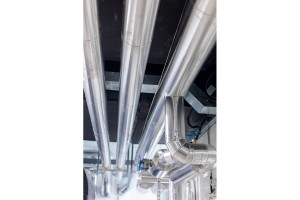Process pipeline insulation
Pipeline insulation layer is also called thermal pipeline insulation layer, which refers to the layer structure wrapped around the pipeline that can play the role of heat preservation and heat insulation. The pipeline insulation layer is usually composed of three layers: insulation layer, protective layer, and waterproof layer. No waterproof layer is required for indoor pipelines. The main function of the insulation layer is to reduce heat loss, therefore, it must be composed of materials with lower thermal conductivity. The outer surface of the insulation layer is generally made of asbestos fiber and cement mixture to make the asbestos cement shell protective layer, and its function is to protect the insulation layer. The outer surface of the protective layer is a waterproof layer to prevent moisture from entering the insulation layer. The waterproof layer is often made of oil felt, iron sheet or brushed glass cloth.
The layer structure laid on the periphery of the pipeline that can play the role of heat preservation and heat insulation generally consists of the following parts:
1) Anti-corrosion layer: Brush anti-rust paint twice on the outer surface of the pipeline;
2) Thermal insulation layer: thermal insulation and thermal insulation material layer;
3) Moisture-proof layer: to prevent moisture from entering the insulation layer, it is generally wrapped with linoleum, and the joints are coated with asphalt mastic, usually used for cold pipelines;
4) Protective layer: To protect the insulation layer from damage, it is usually wrapped with glass cloth on the surface of the intermittent layer;
5) Colored layer: Paint the specified color on the outside of the protective layer to distinguish the fluid in the pipeline.
The purpose of pipe insulation is:
1) Reduce the heat dissipation loss of the medium to meet the pressure and temperature required by the production;
2) Improve working conditions and environmental sanitation;
3) Prevent pipeline corrosion and extend its service life.



